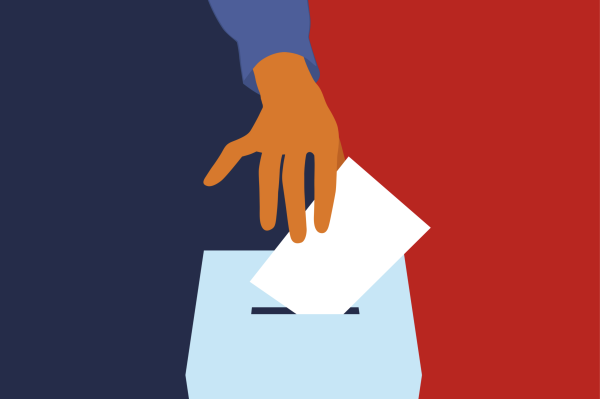Election 2024 National Survey
-
Paul Freedman
Associate Professor, Department of Politics, University of Virginia
-
Jennifer L. Lawless
Leone Reaves and George W. Spicer Professor of Politics, University of Virginia

Overview
The 2024 presidential election unfolded against a backdrop of sharp polarization and widespread concerns about the health of American democracy. To better understand voter experiences and attitudes, University of Virginia professors Jennifer L. Lawless and Paul Freedman, in partnership with UVA’s Karsh Institute of Democracy, conducted a two-wave national survey before and after Election Day. The findings highlight both partisan divides and areas of common experience and shared opinions, even as Republicans and Democrats entered the 2024 race with starkly different views of the 2020 election’s legitimacy.
More than 90 percent of survey respondents reported voting, with Democrats 13 percent more likely to vote by mail and Republicans 8 percent more likely to vote in person. Despite other partisan differences, nearly all voters described positive voting experiences, citing short wait times, smooth procedures, and confidence in poll workers and the administration of polling places.
Voting Experience

Large majorities of Democrats and Republicans reported that they preferred democracy to other forms of government. Concerns about its health, however, remained high across the political spectrum with respondents from both political parties expressing concern that democracy was either “under attack” or “being tested.” After Donald Trump’s victory, however, Republican worries eased significantly while Democrats’ concerns remained about steady. Confidence in the integrity of elections followed a similar trajectory: Republicans’ confidence levels rose sharply, while that of Democrats declined only slightly.
View of Democracy

Large majorities of Democrats and Republicans considered democracy the preferred form of government, even as concerns about its health remained high across the political spectrum.
Trust in government and media revealed both overlap and division. Voters in both parties placed more trust in their state government than in the federal government, though Democrats were more likely than Republicans to express trust in the federal government. Similarly, a majority of respondents from both parties said they had more trust in local news media than national news media, while Democrats were more likely than Republicans to trust national media.
Even amid these divides, large majorities of Democrats, Republicans, and independents agreed on a core democratic norm: their party should accept election results if it loses. And large majorities indicated that they didn’t think it was more important that their candidate wins than that an election is free and fair. Yet, Republicans were also more inclined than Democrats to support a leader who was “willing to break some rules” to set things right, although just over a majority of Republicans disagreed or strongly disagreed with that statement.
Large majorities of Democrats and Republicans considered democracy a preferable form of government, even as concerns about its health remained high across the political spectrum.
On the question of how voters engaged with political news, about half (49 percent) the survey respondents reported seeking out political news and about half (51 percent) said they happened to come across it. This was the case for Republicans and Democrats alike, including partisan leaners. Pure independents, however, were far more likely to stumble upon political news.
Engagement With Political News

Television remained a primary source of news for voters in 2024, but Democrats and Republicans relied on different TV outlets. Voters also reported that they relied heavily on social media as news sources, with high levels of use across platforms—especially YouTube, Facebook, and Instagram—yet trust in it was strikingly low. Specifically, 67 percent of Republicans and 63 percent of Democrats reported “not very much” or “not much [trust] at all” in these platforms to report news “fully, accurately and fairly.” That means that roughly two-thirds of voters in both parties reported having little confidence in the news they consumed on social media.
Voters reported that they relied heavily on social media as a news source, with high levels of use across platforms—especially YouTube, Facebook, and Instagram—yet trust in it was strikingly low.
On election reforms, Democrats strongly favored proposals such as automatic voter registration for all citizens over the age of 18, with six times as many Democrats as Republicans supporting that proposal. But other broad areas of consensus emerged: Strong majorities of both parties supported making Election Day a national holiday and automatically registering voters at their new address when they move. In addition, a majority of both Republicans and Democrats supported requiring all voters to present a government-issued photo ID at the polls (97% and 76%, respectively).
In aggregate, these findings reveal a democracy marked by partisan divides in trust, media consumption, and election reforms. Yet they're also shaped by widely shared positive voting experiences, broad agreement on a preference for democracy, the democratic norm that their candidate should abide by election results, and pockets of bipartisan support for strengthening the electoral system.
Meet the Professors
Methodology
We conducted a two-wave national survey of registered voters (including those who planned to be registered by Election Day). In a pre-election survey, we interviewed a sample of 1,264 respondents between October 12 and November 4, 2024. Following the election, we completed re-interviews with 1,217 of these respondents (from November 6 to November 19). SSRS, a survey research firm, administered the survey using a probability sample drawn from its Opinion Panel. Both surveys were short; the average completion time was approximately 11.5 minutes for the pre-election wave and 7 minutes for the post-election wave. The data are weighted to target population parameters, and the effective margin of error for the entire sample is 3.5 percentage points. In the full report, see Appendix A for sample demographics and Appendices B and C for frequencies.
Download Full Report
About the Authors

Paul Freedman
Associate Professor, Department of Politics, University of Virginia
Director, Environmental Thought and Practice major, University of Virginia

Jennifer L. Lawless
Leone Reaves and George W. Spicer Professor of Politics, University of Virginia
Chair, Department of Politics, University of Virginia
Partners
